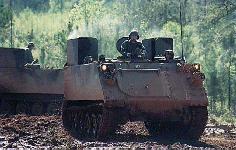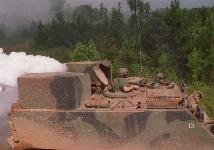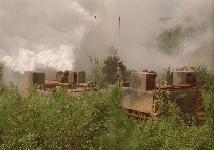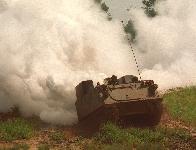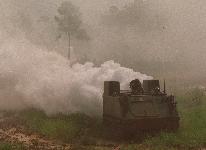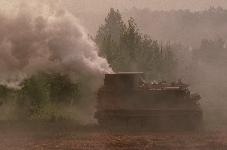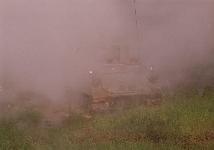 The M1059A3 is an
upgraded Smoke Generator Carrier incorporating the RISE power package for
improved mobility, and carries the M157A2 smoke generating system. It provides
multi-fuel options, including diesel, for smoke generation.
The M1059A3 is an
upgraded Smoke Generator Carrier incorporating the RISE power package for
improved mobility, and carries the M157A2 smoke generating system. It provides
multi-fuel options, including diesel, for smoke generation.
The M1059A3 will be fielded to Force Package 2 and Force Package 3 units. An upgrade to the M157 smoke generator system became available in early 1996 and is currently being applied to vehicles.
CAPABILITIES:
- Produces 90 minutes of mobile, visual obscuration without refueling
- One platoon (6 systems) can screen a 1 km x 5 km area
- Uses any standard Army fuel (including diesel, JP4, JP8, MOGAS)
- Can operate -25°F to 120°F at altitudes up to 8,000 ft.
Description
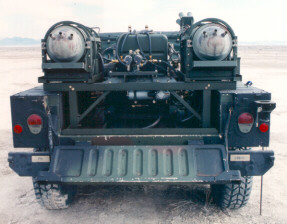 The M157A2 Smoke Generator Set (SGS)
and M1059/M1059A3 Smoke Generator Carrier (SGC) produce large area visual
smoke screens on the move. The M157A2 and M1059/M1059A3 use dual pulse jet
engines, operating on standard Army fuels, to produce large white clouds of
fog oil vapor which defeat visual-range observation and tracking methods,
including lasers. The M157A2 and M1059/M1059A3 consist of 5 major components:
Two (2) M54A2 Smoke Generators, an Air Compressor Assembly, a 120 Gallon Fog
Oil Tank, a Fog Oil Pump Assembly, and a Control Panel. When mounted on
an M1037/M1097 HMMWV with the M284A1 Mounting Kit, these components comprise
the M157A2 SGS. When mounted on the M1059/M1059A3, variants of the
M113A2/M113A3 Armored Personnel Carrier, these components comprise the
M1059/M1059A3 SGC.
The M157A2 Smoke Generator Set (SGS)
and M1059/M1059A3 Smoke Generator Carrier (SGC) produce large area visual
smoke screens on the move. The M157A2 and M1059/M1059A3 use dual pulse jet
engines, operating on standard Army fuels, to produce large white clouds of
fog oil vapor which defeat visual-range observation and tracking methods,
including lasers. The M157A2 and M1059/M1059A3 consist of 5 major components:
Two (2) M54A2 Smoke Generators, an Air Compressor Assembly, a 120 Gallon Fog
Oil Tank, a Fog Oil Pump Assembly, and a Control Panel. When mounted on
an M1037/M1097 HMMWV with the M284A1 Mounting Kit, these components comprise
the M157A2 SGS. When mounted on the M1059/M1059A3, variants of the
M113A2/M113A3 Armored Personnel Carrier, these components comprise the
M1059/M1059A3 SGC.
The M54A2 is a pulse jet engine which burns any mid-viscosity fuel (diesel, JP4, JP8, etc.) to vaporize fog oil which recondenses in the atmosphere to produce a thick, white cloud which provides visible obscuration. Each M54A2 is capable of vaporizing 40 gallons of fog oil in a one hour mission.
Status
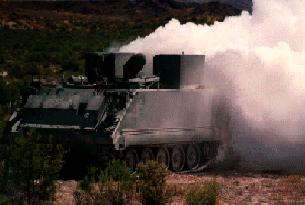
PM Smoke is modernizing the smoke fleet. With the type classification of the M56 and the M58 Smoke Generator Systems, the Force Package 1 and 2 units will be receiving the newest smoke generator systems. At the same time, the force package 1 and 2 turned in equipment will be modernized to the M1059A3 and the M157A3 and refielded to Force Package 3 and 4 units to reduce operational and support costs. Within each of these programs, modernization efforts are underway.
The M157A2/M1059A3 was Type Classified, Standard, Logistics Control Code A on 15 Dec 94. A production contract was awarded to the Minowitz Manufacturing, Co., Rosedale, MI, on 29 Mar 96. This contract was awarded on a Best Value basis using the Performance Specification as the guiding technical documentation. Minowitz is contracted to produce 288 new M157A2 SGSs as well as 342 Modification Kits to upgrade the Army's inventory of M157s and M1059s. Through Mar 98, 152 new M157A2 SGSs have been delivered as well as all 342 Modification Kits. The remaining systems were scheduled for delivery in FY98.
All personnel involved in the production contract participated in Partnership Training, given by DDI, Inc. as part of the Start of Work meeting. Participants included members of PM Smoke/Obscurants, Armaments, Chemical, and Acquisition Logistics Activity (ACALA), Defense Contract Management Command - Team Northeast, and Minowitz and their subcontractors, Majestic Metals and PJP Packaging. Partnership has proven valuable in allowing Minowitz to complete their portion of the First Article Testing at Dugway Proving Ground, UT; reduced turnaround on technical issues; better understanding of Minowitz' design; and design improvements discovered during Production Verification Testing.
A total of 356 systems have been fielded through Mar 98, 219 M157A2 SGSs, 87 M1059A3 SGCs, and 50 M1059 SGCs. A team of personnel from PM Smoke, TACOM-ACALA Chemical Group, ARL, and CBDCOM (RI) are performing equipment deprocessing, New Equipment Training (NET), and Modification Kit installation. An additional 188 systems (159 M157A2 SGSs and 29 M1059 SGCs) were scheduled for fielding in FY98.
History:
The M157 Smoke Generator Set was originally fielded in 1986 and provided the Army with its first mobile smoke generator capability. A total of 323 M157 SGSs and 276 M1059 SGCs were fielded.
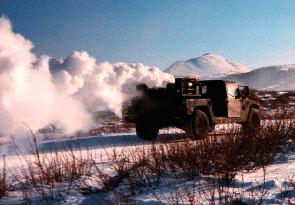 In 1991, the Army began an improvement program to improve the reliability of
the system. The M157A1 was Type Classified Standard, Logistics Code A on
8 Oct 93, but was never fielded. Improvements included in the A1 include fuel
filter/water separator assemblies to protect the fuel pump; simplified fuel can
lid assemblies; elimination of expensive quick-disconnects; improved high
altitude engine head/fuel nozzle/oil orifice; new engine head wrench; smaller
control panel; elimination of hot control panel concerns; repositioning of the
control panel in the HMMWV to prevent interference with the SINCGARS radio;
improved and less expensive fire detection system; fuel pump and fog oil pump
circuit breakers; and relocated and simplified fog oil pump assembly.
In 1991, the Army began an improvement program to improve the reliability of
the system. The M157A1 was Type Classified Standard, Logistics Code A on
8 Oct 93, but was never fielded. Improvements included in the A1 include fuel
filter/water separator assemblies to protect the fuel pump; simplified fuel can
lid assemblies; elimination of expensive quick-disconnects; improved high
altitude engine head/fuel nozzle/oil orifice; new engine head wrench; smaller
control panel; elimination of hot control panel concerns; repositioning of the
control panel in the HMMWV to prevent interference with the SINCGARS radio;
improved and less expensive fire detection system; fuel pump and fog oil pump
circuit breakers; and relocated and simplified fog oil pump assembly.
In Oct 93, a Materiel Change was initiated to comply with DOD Directive 4140.43 on fuel standardization. The result of this Materiel Change, the M157A2 SGS, utilizes an innovative new method for igniting and burning mid-viscosity fuels (Diesel, JP8, etc.) in a pulse jet engine. The PM Smoke personnel who developed this new method were awarded a patent on 9 Sep 97 entitled "Multifuel Combustion Engine and Use In Generating Obscurant Smoke" (U.S. Patent #5,665,272).
Modernization Through Spares
In order to reduce O&S costs, PM Smoke has been aggressively updating fielded systems through a Modernization Through Spares (MTS) strategy.
Improvements identified during the M157A1/A2 development and production efforts have been stocked for the original M157 SGS, resulting in decreased O&S costs and extending the serviceable life. These new parts have been incorporated using the NSNs of the replaced parts, thereby requiring no change in requisitions. These parts include the Improved Fuel Can Lid Assembly, Pressure Switches, and Thermal Switches.
The MTS initiatives are being incorporated into the Technical Manuals (TMs). The TMs to include the 12&P have also been updated and contain all improvements to the system. PS Magazine articles describing changes have been published and additional articles will be developed as new initiatives arise.



